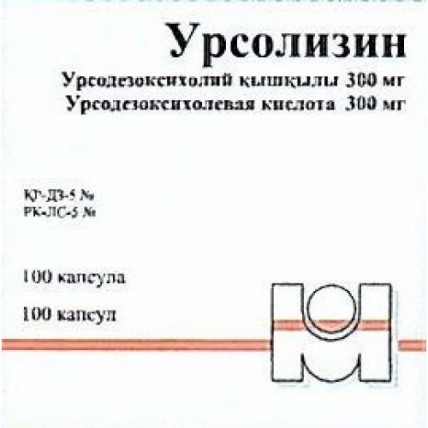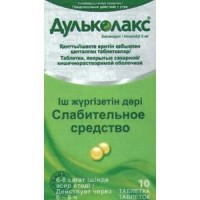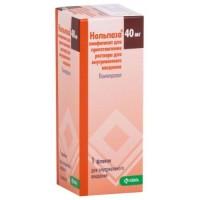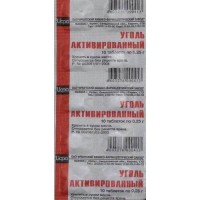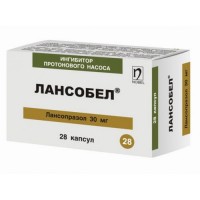Ursolisin 100s 300 mg capsule
- $136.90
Out Of Stock
The instruction for medical use of Ursolisin medicine the Trade name Ursolisin Mezhdunarodnoye the unlicensed name Ursodezoksikholevaya acid the Dosage form of the Capsule of 150 mg and 300 mg Structure One capsule contains active agent – ursodezoksikholevy acid of 150 mg or 300 mg, excipients: corn starch, magnesium stearate, silicon dioxide colloidal anhydrous, structure of a gelatin capsule: titan dioxide (E 171), gelatin. Description Solid gelatin capsules of white color. Contents of capsules – white powder (formation of conglomerates is possible) Pharmacotherapeutic group Drugs for treatment of diseases of a liver and biliary tract. Drugs for treatment of a gall bladder. Drugs of bile acids. Ursodezoksikholiyevy acid. The ATX A05AA02 code the Pharmacological Pharmacokinetics Later properties of oral administration ursodezoksikholevy acid is absorbed in digestive tract as by passive diffusion in lean and colonic guts, and at the expense of active transport in an ileal gut. Ursodezoksikholevy acid is metabolized mainly in a liver and removed in the conjugated form with bile by enterogepatichesky recirculation and partially – with excrements. A pharmacodynamics of Ursodezoksikholevaya acid is a bile acid which is physiologically produced in intestines of the person from cholic or chenodesoxycholic acids. Ursodezoksikholevy acid reduces cholesterol content in bile due to suppression of its synthesis and secretion by a liver and also inhibits intestinal absorption of cholesterol. The therapeutic effectiveness of drug is caused by its ability to normalize holepoetichesky function, to reduce a bile litogennost, to prevent formation of bilious concrements and to promote dissolution of already available cholesteric gallstones. Ursodezoksikholevy acid eliminates the dispeptic symptoms accompanying gepatobiliarny pathologies and is applied in cholestatic diseases of a liver. Indications - for dissolution of the cholesteric X-ray negative stones of a gall bladder which are not exceeding 15 mm in the diameter at the functioning gall bladder - for treatment biliary a reflux gastritis - for treatment of primary biliary cirrhosis in the absence of signs of a decompensation as a part of complex therapy the Route of administration and doses For dissolution of cholesteric gallstones select the Dose of drug individually. Usually daily dose of drug makes 10 mg/kg of body weight. Capsules are recommended to be accepted once a day before going to bed, without chewing and washing down with a small amount of water. Treatment duration for dissolution of the available concrements has to be from 6 to 12 months and more. Each 6 months it is necessary to control efficiency of therapy by means of ultrasonic or X-ray inspection. If after 6 months of treatment of reduction of the sizes of gallstones it is not observed, then further continuation of therapy is inexpedient. For prevention of a recurrence of cholelithiasis it is recommended to continue administration of drug for 3-4 months after dissolution of the available concrements. For treatment biliary the reflux gastritis At treatment biliary a reflux gastritis is usually accepted on 150 mg of drug one or twice a day. Duration of treatment is defined by the doctor for each patient individually. For symptomatic treatment of primary biliary cirrhosis the Daily dose of drug is selected the doctor individually and usually makes 10-15 mg/kg of body weight. For the first months of treatment it is recommended to divide a daily dose into 2-3 receptions. At improvement of indicators of hepatic function the dose of drug can be accepted one-time in the evening. Therapy can be carried out beyond all bounds long. Side effects - diarrhea, nausea, vomiting, abdominal pain with localization in right hypochondrium or in epigastric area, a constipation, passing increase in activity of hepatic transaminases - calcination of bilious concrements - urticaria, a skin itching - the cirrhosis decompensation at treatment of primary biliary cirrhosis in an advanced stage of a disease which is partially regressing after drug withdrawal of the Contraindication - hypersensitivity to active agent, bile acids or auxiliary components of drug - the X-ray positive (calcinated) concrements of a gall bladder - obstruction of biliary tract (obstruction of the general hepatic or vesical channels) - acute inflammatory diseases of a gall bladder, biliary tract or intestines, including an empyema of a gall bladder - disorder of motor activity of a gall bladder, a nonfunctioning gall bladder, bilious fistula - cirrhosis in a decompensation stage - a heavy liver or renal failure - frequent biliary gripes - acute pancreatitis Medicinal interactions Ursolisin it is not necessary to appoint along with holestiraminy, kolestipoly or the antiacid drugs containing hydroxide or aluminum oxide as these drugs in intestines connect ursodezoksikholevy acid and, thus, inhibit its absorption and reduce efficiency of therapy. If necessary these drugs need to be taken, at least, with a 2-hour interval to or after Ursolisin's reception. Ursodezoksikholevy acid can increase intestinal absorption of cyclosporine. Therefore when performing such combination therapy it is necessary to control the serumal level of cyclosporine and if necessary to regulate its dose. In some cases ursodezoksikholevy acid can reduce ciprofloxacin absorption. Ursodezoksikholevy acid reduces values of the maximum concentration in blood plasma (Cmax) and values of the area under curve (AUC) of the calcic antagonist of a nitrendipin and also reduces therapeutic effectiveness of dapsone. These data indicate possible induction by ursodezoksikholevy acid cytochrome of P450-dependent enzymes 3A though it was not confirmed in controlled clinical trials. Estrogen and some hypolipidemic drugs, such as Clofibratum, can promote formation of bilious concrements and, thus, reduce efficiency of ursodezoksikholevy acid at dissolution of gallstones. Special instructions for the first 3 months of treatment every 4 week it is necessary to control functional parameters of a liver and to determine activity of aspartate aminotransferase (nuclear heating plant), alaninaminotranspherase (ALT) and gamma glutamiltransferazy (GGT), further such tests are recommended to be carried out every 3 month. Such monitoring allows to establish the patients with primary biliary cirrhosis responding to performing therapy and also to carry out early identification of possible deterioration in hepatic function, especially patients with primary biliary cirrhosis in an advanced stage have diseases. For assessment of therapeutic effect and early detection of possible calcination of concrements in 6 months after an initiation of treatment, depending on the size of stones, it is necessary to conduct a research of a general view of a gall bladder (oral cholecystography) and diagnostics of possible occlusion of bile ducts in a standing position and lying on spin (ultrasonic inspection). Ursolisin it is not necessary to appoint at impossibility of receiving a holetsistogramma of a gall bladder, in the presence of the calcinated concrements, in disorders of motor activity of a gall bladder or frequent biliary gripes. At use of ursodezoksikholevy acid for treatment of primary biliary cirrhosis in an advanced stage of a disease cirrhosis decompensation cases which partially regressed after drug withdrawal very seldom were observed. In case of development of diarrhea it is necessary to lower a drug dose, and in case of persistent diarrhea the treatment should be stopped. Pregnancy and lactation of Sufficient data on use of ursodezoksikholevy acid during pregnancy, especially in the first trimester, it is not received. Prior to drug treatment it is necessary to exclude pregnancy. Women of childbearing age can appoint drug only at the condition of application of reliable means of contraception – use of the non-hormonal or containing low doses estrogen of contraceptives is recommended. However, at dissolution of gallstones the patients should use effective non-hormonal methods of contraception as oral hormonal contraceptives can promote formation of concrements. Ursolisin it is not necessary to apply during feeding by a breast. Children of Special drug use studies for treatment of children it was not carried out. Use of drug at children's age is not recommended. Features of influence on ability to run the vehicle or potentially dangerous mechanisms the Overdose Symptoms does not influence: in case of overdose of drug the development of diarrhea is possible. In general, development of other symptoms of overdose is improbable since at increase in the accepted dose the absorption of ursodezoksikholevy acid decreases and increases its removal with excrements. Treatment: at overdose performing specific therapy is not required, consequences of diarrhea it is necessary to treat symptomatic by means of rehydration and substitution of electrolytes. A form of release and packing On 10 capsules in blister strip packaging from a film of PVC and aluminum foil. On 2 or 10 blister strip packagings together with the instruction for medical use in the state and Russian languages place in a cardboard box. To Store storage conditions at a temperature not over 25 of 0C. To store out of children's reach! 3 years not to apply a period of storage after the termination of the expiration date specified on packing. Prescription status According to the prescription the Producer Mitim of Neuter of l. / Mitim S.r.l. Via Kachchamali, 34-36-38 – 25125 Brescia, Italy (Via Cacciamali, 34-36-38 – 25125 Brescia, Italy) the Owner of the registration certificate: S. Magis Pharmasyyutichi of the item. And., Italy (Magis Farmaceutici S.p.A., Italy) the Address of the organization accepting in the territory of the Republic of Kazakhstan claims of consumers on quality of products (goods): Almaty, Kunayev St., 18, office 6
to Develop representative office of LLC Sona-Pharm in Almaty, RK
to Develop representative office of LLC Sona-Pharm in Almaty, RK
